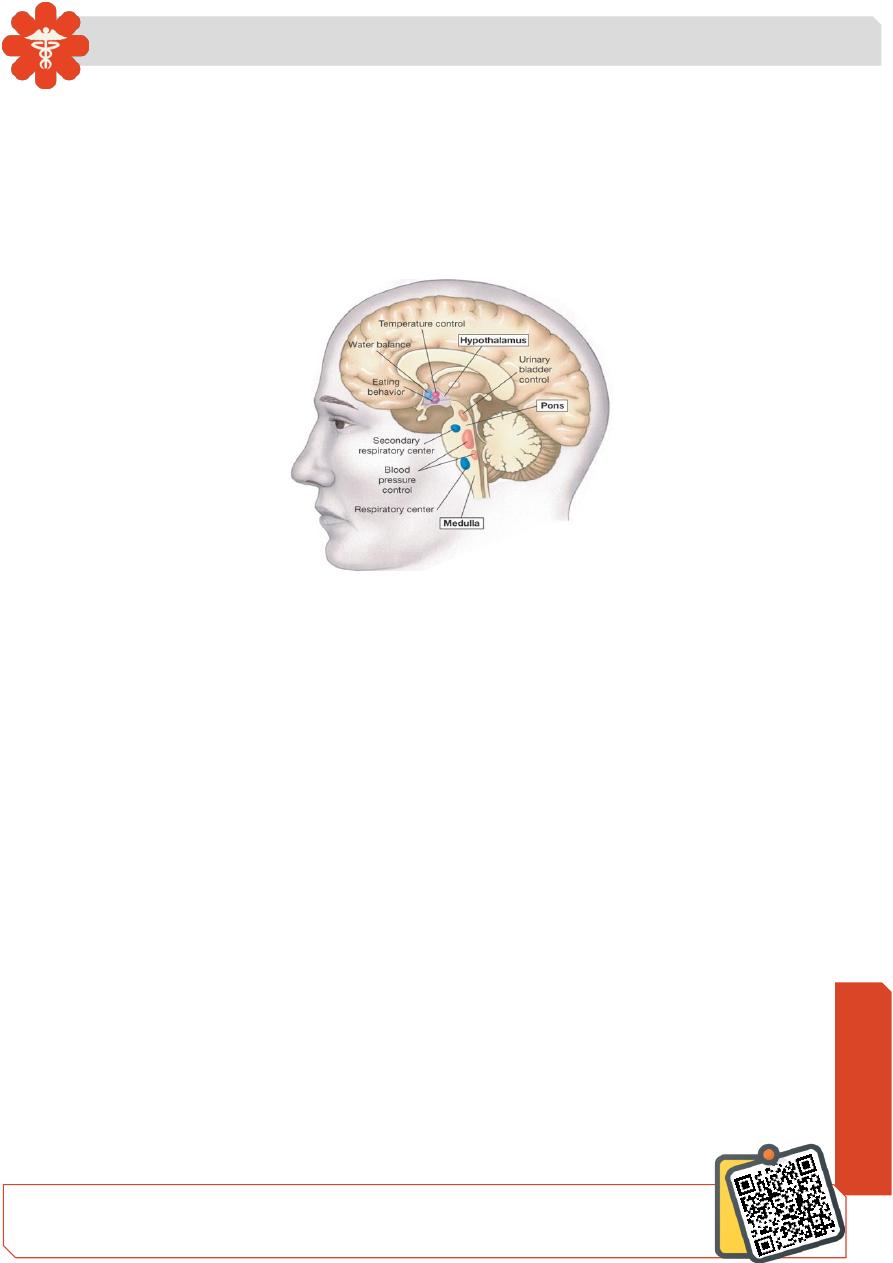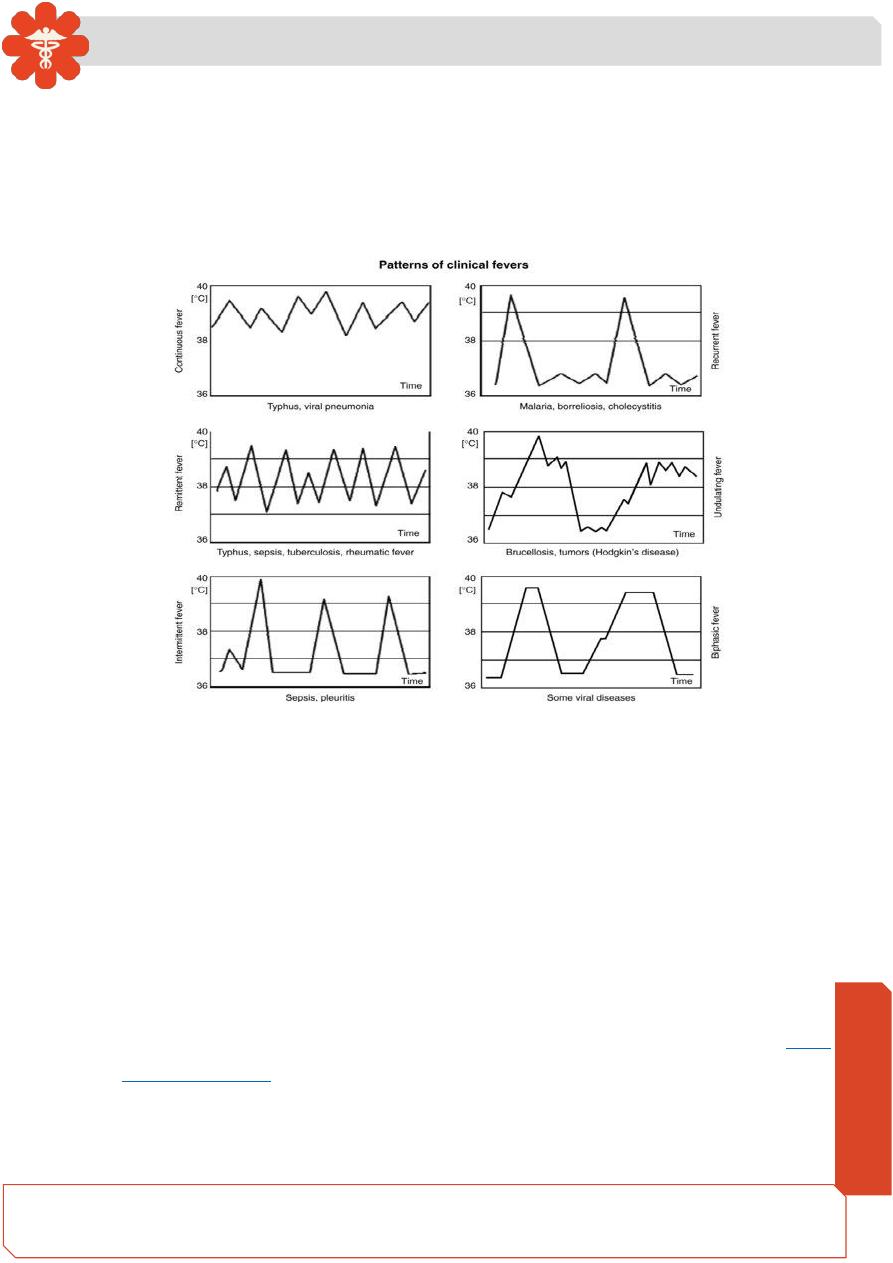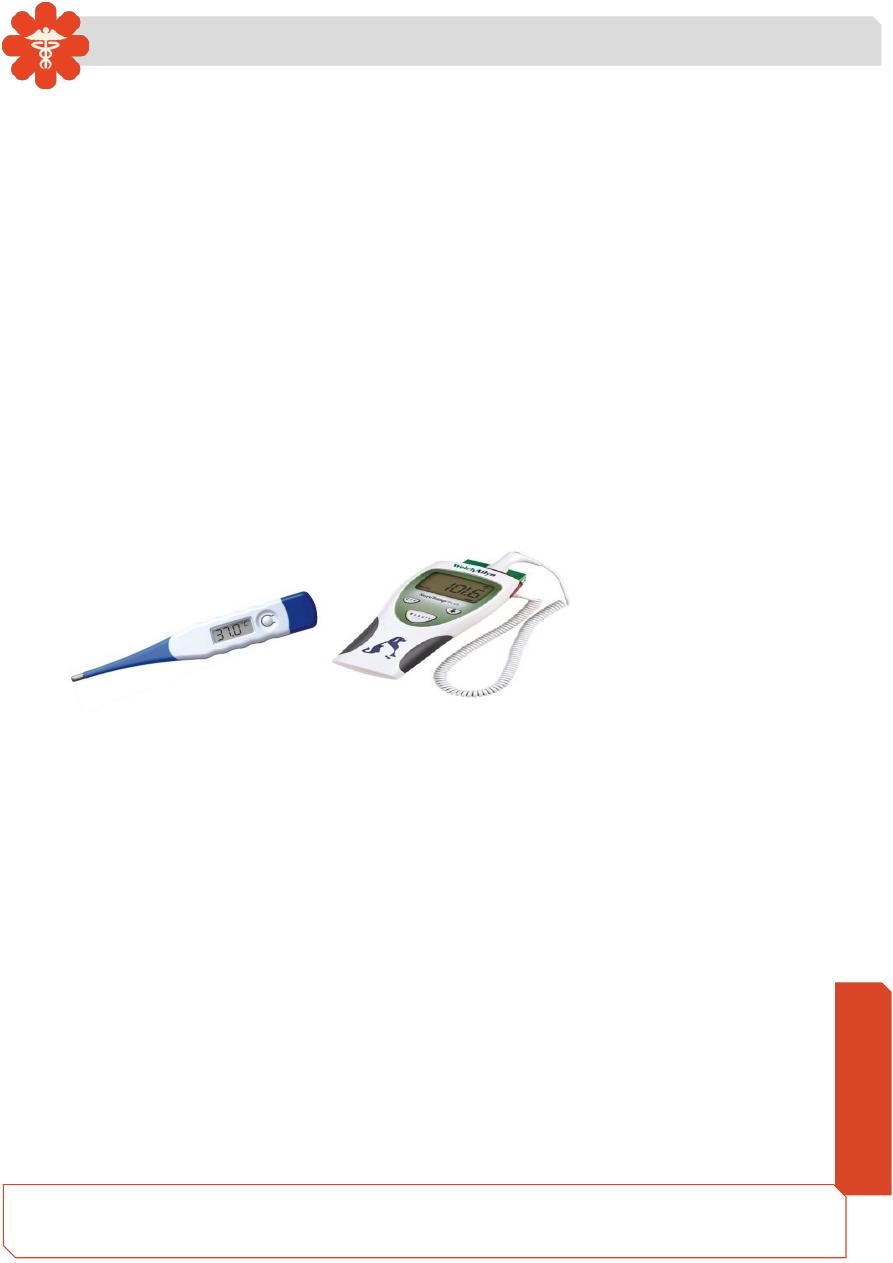
Medicine
Notes…
1
Lecture.7 Fever
Thermoregulatory Center (Thermostat)
Located in brain at hypothalamic region responsible for keeping the internal temp.
at a normal level ( approximately 36.8°C )
(set-point at 36.8 °C)
During fever there is changing in position of set-point to higher level
DEFINITION OF TERMS:
Fever: also known as pyrexia, or a febrile response, is a medical term which describes
an increase in internal (core) body temperature to levels which are above normal (36.8°C
± o.5). 37°C = 98.6°F
Classification of pyrexia:
Pyrexia can be classed as:
• low grade: (38 to 39 °C, 100 to 102.2 °F),
• moderate: (39 to 40 °C, 102.2 to 104 °F),
• high grade: (more than 40 °C or 104 °F) depending on how much the body
temperature has deviated from normal.
• if the fever goes above 42 °C (107.6 °F) then it may cause significant tissue damage
and would most certainly be harmful. This is termed hyperpyrexia.
• Temperature normally fluctuates over the day, and the same applies to fever. If this
characteristic pattern is lost, the raised body temperature may be due to
hyperthermia, a more dangerous disorder. Hyperthermia is commonly caused by
overheating or sunstroke, which elevates the body's temperature above the
thermoregulatory set-point.
N
eed S
om
e H
el
p?

Medicine
Notes…
2
Duration of fever:
1. Short duration: Remaining for few days usually less than 1 weeks. It subsides
spontaneously without specific treatment or investigations. Mostly due to viral
infections.
2. Moderate duration (1W
– 3W ): Usually the cause is known after some simple
investigations, mostly due to bacterial infections like typhoid fever, brucellosis,
malaria …etc but may be due to other causes.
3. Long duration fever: (more than 3ws): Any fever that prolonged for more than 3 Ws
and the cause is not discovered after 10 days of investigations. It is called P. U. O
(pyrexia of unknown origin )
Case scenario:
A 45 year old woman is seen for follow up evaluation of daily fever & fatigue for 1 month.
She reports a temp. of as high as 38.4, but has no weight loss. No previous medical or
surgical or travel history and takes no medication.
On physical exam, pulse 90, Bp 130/80, temp. 38.2. The patient looks well. The
remainder physical exam. all are normal
Investigations:
• CBC : Hb 13.7, WBC= 6.8, platelrt= 179
• Urine exam. is normal
• Renal, liver function tests are normal
• Virology screen normal
• Blood culture show no bacterial growth
• ECG, chest x-ray, and CT scan of abdomen and pelvis are normal
Temperature charts:
Are special sheets arranged in such a way in
which you can put in it the patient recording
temperature at specified time
e. g. at morning and evening although it may be
every hour or every few hours. This sheet is usually
connected to the patient case sheet file in the
different medical wards and the recording of
temperature is performed routinely by nurses.

Medicine
Notes…
3
Fever pattern:
The following are the main patterns of the fever:
– Continous fever: e. g. in typhoid fever
– Remittent fever: e. g. in pus collection (abscesse) or using antipyretic drugs.
– Intermittent fever: e. g. in malaria (Tertiary and Quatrain), Brucellosis
(undulant fever) and Hodgkin Lymphoma
In the past these patterns were considered very important for diagnosis of many
infectious diseases but at present its importance was declined very much because of the
availability of many investigatory tools and new techniques for diagnosis. Adding to this,
these patterns are affected and changed by antipyretic drugs which are commonly
prescribed to such patients.
Fever mechanism:
• Substances which induce fever are called pyrogens. Although external pathogens
may be the ultimate reason for a fever, it is the internal or endogenous pyrogens
that ultimately cause the increase in the thermoregulatory set-point.
• Fever mechanism:
• Pyrogens like e. g. lipopolysaccharide (LPS), which is a cell wall component of
→ which act on Macrophages leading to release of endogenous
pyrogens or mediators like IL 1 and 6, TNF
→These substances go to the brain
through the circulation and prostaglandins E 2 is released which act on
Thermoregulation center in hypothalamus (Re-setting the point up)

Medicine
Notes…
4
• Pyrogens may come from MO, tumors, CT diseases and other inflammatory
processes.
CAUSES OF FEVER:
Fever is a rise in our body's normal temperature,
Fever is part of our body's defense mechanism.
When our bodies are fighting infections, our body
temperature rises. But why? Fever is a symptom of
an infection. Fever is a symptom of almost every
disease known to man. but generally can be arranged in following groups:
1. Infections: The largest and the most important group causing fever. (Viruses,
bacteria, protozoal, helmintics,…etc)
2. 2. Tumors: benign and malignant, lymphoma, leukemia, solid tumors like hepatoma
, hypernephroma,…etc.
3. 3. Connective tissue disaeses (Rheumatological diseases): Like SLE, Rheumatoid
arthritis, Rheumatic fever, still disease ...etc.
4.
4. Drug reactions: e. g. due to penicillin, sulfa drugs…etc.
5. 5. Miscellaneous and factitious: like FMF, Bahcet disease, thyrotoxicosis, Self
induced.
CAUSES OF VERY HIGH FEVER
(> 41.5)
1. Pontine hemorrage (intracranial): Hyperpyrexia
2. Falciparum malaria: Hyperpyrexia.
3. Drug reaction like phenothiazine drugs and some sort of general anasthesia
4. Heat stroke: Hyperthermia.
HEAT STROKE
This is due to overexposure to the sun. The
body cannot bring down the temperature nor
sweat. This is a potentially life threatening situation that requires emergency first aid and
immediate means of bringing down the temp such as, dousing the person in cool water,
giving cool liquids to drink, applying ice packs in axillary and groin areas, and moving the
person out of heat and sun to a cool place.
NO PLACE FOR ANTIPYRETIC

Medicine
Notes…
5
HYPOTHERMIA
Is lowering of body temperature below the normal, usually below 35C. In severe cases
it may drops below 28 C which is fatal and affect the heart and other important organs
and accompanied with bradycardia. Caused by:
1. Hypopitutarism
2. hypothyroidism
3. exposure to extreme cold.
Measurement of body temperature:
person's body temperature is measured using a thermometer. Through:
1. Mouth: The commonest and easiest method for Temp. measurement.(cold and hot
drinks affect the measuring)
2. Axilla or groin: In small children
3. Anal (Rectally): By using special thermometer. Approximate to core body
temperature.
4. Ear: using a special temperature taking device in the ear.
Note:
The temperature through the axilla is 0.5 C less than the Oral Temp.
The rectal temperature is 0.5 C higher than the oral temperature.
FEVER MANIFESTATIONS:
Accompanying high fever the following manifestations may occur:
• Head ache, muscle pain (myalgia), joint pain, back ache and feeling hot.
• Nausea and vomiting.
• Epistaxis may occur.
• Tachycardia
• Redness of checks (flushing of face)
• Chills (fealing of coldness).
• Rigor (shivering): Real shaking of the body and teeth chattering (to raise Temp by
muscle activity).
• and sweating (to reduce Temp) when fever drops.

Medicine
Notes…
6
• Seizures (fit or convulsion): This is the most important and serious manifestation of
high fever and especially occur in children. Repeated febrile convulsion may lead
to serious brain damage.
• Another manifestation of the fever is confusion: which also commonly occur in
children and elderly people.
Note: Fever also cause changes in endogenous proteins like globulin level, haptoglobin,
ferritin, proteinuria, concentrated urine, high ESR, changes in WBCs count (leukocytosis),
changes in coagulation factors and other acute phase reactant substances.
FEVER TREATMENT
1. Specific treatment for the cause of fever
2. Non specific measures to reduce the fever
Some comfort measures for someone with a fever include:
• fever-reducing medications,
• cool wet rag on the head,
• cover in light blanket (heavy blankets actually trap the heat),
• avoid taking hot baths,
• drinking plenty of fluids, especially clear cool liquids such as water and fruit juice
to prevent dehydration,
• if the fever is high, you may give a light sponge bath using tepid water only, not
cold water, and no alcohol!,
• Keep the person covered with a towel as not to get a chill.
• An infant or small child with a high fever can dehydrate very quickly, especially if
they are losing fluids some other way, as well, such as diarrhea or vomiting. If they
are not vomiting, give them as much liquid as they can tolerate to prevent
dehydration. There are specially formulated liquids on the market for replenishing
the body and maintaining electrolyte balance. If the child is vomiting
Antipyretic and anti-inflammatory drugs:
1. Paracetamol: Analgesic and anti-pyretic
2. Aspirin, Ibuprofen, Diclofenic acid and other NSAID.
3. Steroid drugs like hydrocortisone and prednisolone.
